A quick note beforehand:
In this article, we want to make it visible that women and men are social constructs. For this purpose, words such as femininity/masculinity/man/woman are written with an asterisk at the end (e.g. femininity*). This spelling is also intended to draw attention to the fact that trans* and inter* persons are also meant by man* and woman*.
Somewhere over the Rainbow – The Rainbow as a Symbol
We encounter colorful rainbow flags and symbols every day. The rainbow in the Pride context has arrived on almost every product. Whether clothing or drinks bottles, books, headphones or even food. The symbol stands for peace, tolerance and diversity. Those who raise the flag speak out for the LGBTQIA+ community and for freedom of sexual and gender identity.
There are now numerous Pride flags, each with its own individual meaning.
This blog article provides an overview of the meanings and origins of Pride flags. As these are constantly being tweaked and changed, we cannot give any assurance of a complete representation here.
A_romantic
One of the most important distinctions is between sexuality and gender. Agender refers to gender identity, while a_romanticism and a_sexuality refer to sexuality, as the name suggests. People who identify as a_romantic do not experience much or any romantic feelings towards others. A_romanticism has many shades, and the flag aims to illustrate this. The dark and light green represent the a_romantic spectrum, the white stripe represents platonic relationships, and gray and black represent the (a_)sexual spectrum. However, not every a_romantic person is automatically a_sexual.
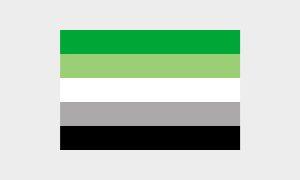
A_sexual
A_sexual people have no or little sexual interest in others. A_sexuality does not necessarily have to coincide with A_romanticism. The flag was chosen by voting in a forum for A_sexual people in 2010. Black here stands for A_sexuality, grey for the A_sexual spectrum, white for sexuality and purple for the community. However, white could also be associated with demisexuality. This means that demisexual people are only physically attracted to a person if they have established an emotional bond with that person.
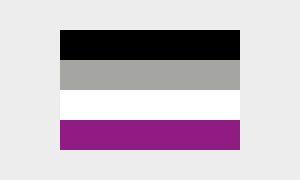
Agender
People who state agender as their gender identity do not identify with the binary gender system. This means that they categorize themselves as neither man* nor woman*, but neutral or genderless. The Agender Pride flag was designed by Salem X in 2014. The color scheme of this flag says different things. For example, the black at the top and bottom and the white represent the complete non-existence of gender. Grey forms the intermediate levels between black and white, the so-called “semi-gender”. That is, the person partially identifies with the binary gender system, but is also partially non-binary. The green in the middle stands for the non-binary gender identity, as it is a mixture of the colors pink and blue. These stand for a man* and woman* respectively.
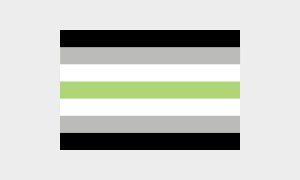
Bisexual
Bisexual people are sexually attracted to women* as well as men*. Sexuality does not change when a bisexual person is in a relationship. For example, a woman* remains bisexual even if she is in a relationship with a heterosexual man*. A reinterpretation or extension of the term is bisexuality. Here, all genders are sexually attractive (polysexual). This breaks down the binary gender system and questions bisexuality. The flag was designed by Michael Page in 1988 to give bisexuality more visibility in the LGBTQIA+ community and in society. The pink at the top represents same-sex love, the purple in the middle represents non-gender love and the blue represents love for another gender.
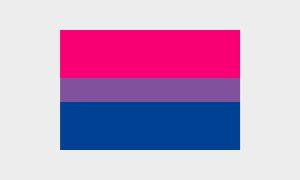
Demi-gender
Demi-gender describes partial identification with gender identity. A distinction is made between demi boys and demi girls. The persons who classify themselves as demi-gender define themselves predominantly, but not exclusively, as female*/male* or masculine*/feminine*. It should be noted that the assignment is independent of the gender assigned after birth. The colors of the Pride flag are White for A_gender, blue for masculine* or pink for feminine* and grey for the gender spectrum.
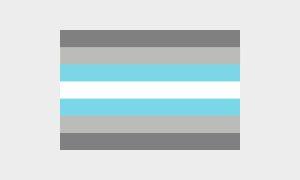
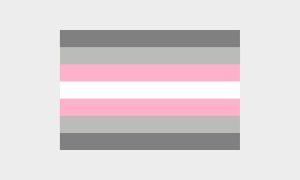
Demisexual
People who belong to the demisexual spectrum only develop sexual attraction when there is an emotional connection to a person. However, this does not necessarily mean that the emotional attachment leads to sexual interest, it is merely a condition for physical attraction. The colors and interpretation of the flag are based on those of the a_sexual Pride flag. The difference is the different arrangement of the color stripes.
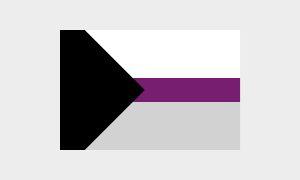
Flags of lesbian women* – old and new
The old flag for lesbian women*, which stood for femininity*, was redesigned in 2018 by Emily Gwen on Twitter as well as Tumblr. The old flag was interpreted as anti-trans* as well as anti-butch, as it only included pink stripes. “Butch” as an English word for “guy” is a (self-)designation for lesbians who appear as “masculine” according to heterosexual stereotypes. The new flag should also include those without a she/her pronoun, trans* as well as non-binary lesbians. The meaning of the stripes from top to bottom is gender nonconformity, independence, community, special relationship to femininity*, clarity and peace, love and sex, and femininity.
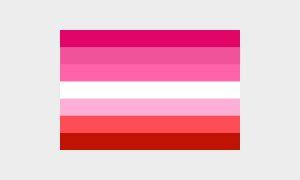
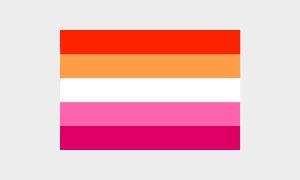
Gay Men’s Flags*
The Pride flag for gay men did not come into being without controversy. The rainbow Pride flag, which was originally only for the gay community, gradually opened up to all identities in the LGBTQIA+ community. As a result, the desire was expressed to develop a separate flag for gay men. The design was initially controversial as it strongly resembled the lesbian Pride flag and the creator was accused of being trans* hostile. However, both these allegations were debunked and the flag was accepted by the community.
The meaning of the colors is: turquoise and green for community, healing and joy, white for a_gender, non-binary and trans* people, and blue to purple represent pure love, strength and diversity.
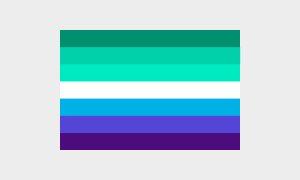
Genderfluid
Genderfluid is a non-binary gender, but genderfluid persons can also temporarily locate themselves in the binary gender system, depending on the situation. The blue stripe here stands for masculinity*, black for all gender identities beyond the binary understanding of gender, purple for a mixture of femininity* and masculinity*, white for the absence of gender and pink for femininity*.
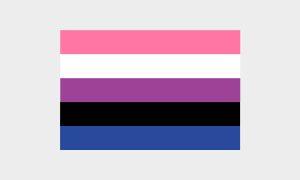
Genderqueer / Nonbinary
In 2010, the Pride flag for genderqueer and non-binary people was designed by Marilyn Rode.
Queer means above all a rejection of gender pigeonholing. A demarcation of binarity and cisnormativity takes place. Purple here stands for the mixture of male* (blue) and female* (pink) and thus also for androgyny and queerness. White symbolizes the people who identify as a_gender. The green stripe serves as a counter color to the purple and is dedicated to people who locate themselves outside the gender binary.
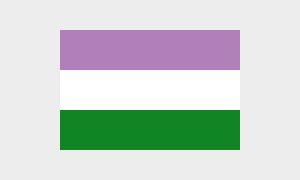
Heterosexuel / Straight Ally
People who want to support the LGBTQIA+ community but define themselves as heterosexual can also express this with a flag. This symbolizes the common fight against queer hostility and for the rights of the queer community.
The A is meant to express Ally. The rainbow colors the LGBTQIA+ people, black and white heterosexual and cis people respectively.
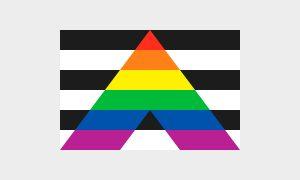
Intersexuality
In 2013, the Pride flag for inter* people was designed by the organization Intersex International Australia. The term inter* is an umbrella term for self-designations such as intersex, intergender, intersexual, or intersexual. Inter* people cannot be clearly classified into a physical gender, i.e. neither genitally nor according to hormones or chromosomes. Therefore, operations that violate human rights are usually carried out in infancy, which can often lead to severe subsequent problems. The flag of intersexuality symbolizes wholeness and the right to be the person who wants to be human. These viewpoints are represented by the circle as unbroken, holistic and respecting the potential of inter* persons. Purple and yellow are meant to be gender non-specific. The inter* movement is still fighting for their rights to bodily integrity.
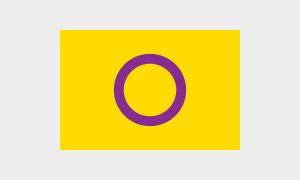
Neutrois
The neologism neutrois was created by H.A. Burnham in 1995. It describes a third, neutral gender and thus stands alongside females* and males*. The difference between a_gender and neutrois is that neutrois people do not assign themselves to a gender like a_gender people, but to the third, neutral gender. The colors have the following meaning here:
White stands for neutral gender, green is the opposite color of purple (the mixture of pink and blue) for non-binary gender and black stands for a_gender people.
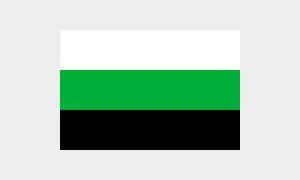
Nonbinary
Kye Rowan designed a Pride flag for non-binary people in 2014. This serves to address people who do not feel represented by the genderqueer Pride flag. Nonbinary serves as an umbrella term for various gender identities, including, for example, agender, neutrois, androgynous, mixed-gender, genderfluid, bigender, genderqueer, demi-boys, and demi-girls.
Yellow as a gender-neutral color is intended to address people who locate themselves beyond the two-gender norm. White stands for people of several or all genders. Fluidity and a gender between male* and female* is represented by the color purple. Black represents people who do not feel they belong to any gender.
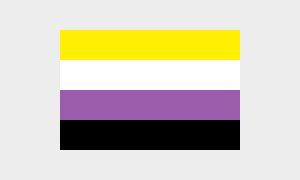
Pansexuel
In 2010, Jasper designed its own flag for the pansexual community. Pansexual people are attracted to others regardless of gender and sexual identity. This correspondence is also reflected in the flag: magenta stands for attraction to the female* spectrum, cyan for the male* and yellow for attraction to all non-binary people.
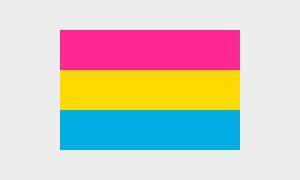
Polyamory
Polyamory means that a person has the capacity to love multiple people and/or live in multiple relationships by mutual consent.
Jim Evans designed the flag for polyamorous people as follows: Blue for openness and honesty with all parties involved in the relationship. Red for love and passion, black for solidarity with people who cannot come out. The middle pi symbol also stands for openness, but beyond that also for unconditionality. This symbol is meant to reflect the initial letters and is in gold to emphasize the importance of emotional relationships. In 2017, the flag was modified by replacing the pi symbol with an infinity heart.
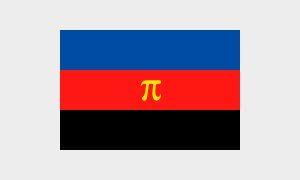
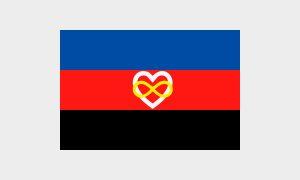
Polysexual
This term describes sexual orientation that includes multiple but not all genders. Polysexuality differs from polyromanticism in that it refers to sexual rather than romantic relationships. In 2012, Samlin created the polysexual pride flag.
The meaning of the flag is as follows: Pink represents attraction to female* identified people, green represents attraction to people who identify outside the traditional male* female* binary and blue represents attraction to male* identified people.
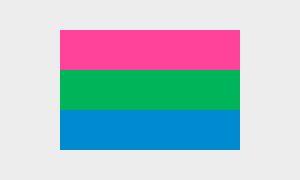
Progress Flag and Intersex Inclusive Pride Flag
In 2017, the Progress Flag was designed by Daniel Quasar. This interpretation of the first rainbow flag was meant to underline the progress that has already been made on the one hand and still lies ahead of society on the other. The wedge of the colors of the trans* pride flag and the brown and black of the BIPOC community symbolizes this progress and point toward the wind in the waving flag. The black stripe has two meanings. On the one hand, it represents the BIPOC community, and on the other hand, it represents all people who are living or have died from AIDS and its stigmas.
The Progress Flag has been updated once again and now also includes the purple circle as the Intersex Inclusive Pride Flag. This symbolizes “being unbroken and whole” and the right to make your own decisions about your own body.
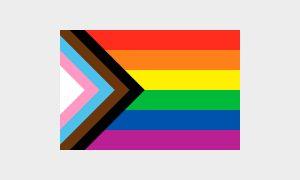
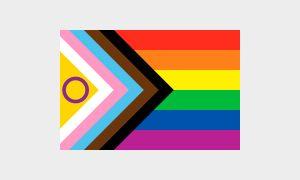
Rainbow flag
In 1978, the first Pride flag was designed by Gilbert Baker in San Francisco. This was commissioned by Harvey Milk, the first openly gay man to hold public office in the United States. The two men were already friends and wanted to create a positive symbol for the queer community and for Gay Freedom Day, a precursor to today’s Pride and CSD parades. Baker based his design on the existing rainbow flags of the peace movement and the Inca Empire. However, the rainbow as an anti-war symbol consists of seven stripes, starting with the blue tones at the top and ending with the red tones at the bottom. It also usually featured a “peace” inscription in the respective national language. Whether Peru actually hoisted the seven-striped rainbow flag is disputed by the Academy of Peruvian History, but since 1978, the rainbow flag has been the official symbol of the Peruvian city of Cusco.
The first flag designed by Gilbert Baker for Gay Freedom Day featured eight stripes, with the colors pink, red, orange, yellow, green, turquoise, blue, and purple, which he hand-dyed. Pink could not yet be printed on fabrics en masse at that time and was therefore left out. Turquoise was also removed due to the odd number of stripes, so the flag became known with six stripes.
The rainbow flag served as a positive alternative to the pink triangle. The triangle, introduced by the Nazis to identify and persecute homosexual individuals, was reclaimed in the 1970s as a courageous symbol of remembrance and action against persecution. The flag is usually hoisted with a red stripe at the top, resembling a rainbow, and symbolizes diversity, pride, and tolerance.
Each color has a meaning: Pink stands for sexuality, red for life, orange for healing, yellow for the sun, green for nature, turquoise for art, blue for harmony, and purple for spirituality.
In 2017, an optimized version of the rainbow flag was introduced in Philadelphia as part of the More Colors – More Pride campaign. Since people of color (BIPOC) in the queer community are particularly affected by multiple discrimination, this flag was meant to signal against xenophobia and racism. For this purpose, a brown and a black stripe were added to the rainbow flag.
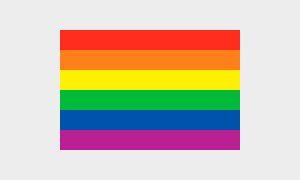
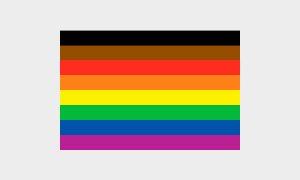
Trans*Pride flag
Trans* serves as a collective term for all forms of transsexual, transsexuality, trans identity, transgender and non-binary. People who feel that the gender assigned to them after birth (usually on the basis of genitalia) does not describe them or does not describe them sufficiently use trans* as a classification. In this context, the star illustrates the diversity in the community and is thus meant to be more inclusive. The Trans* Pride flag was designed by Monica Helms in 1999. The blue stripes represent masculinity*, the pink represents femininity* and the white stripe represents non-binary, inter* and trans* people.
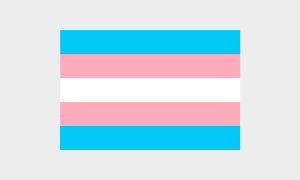
We hope that this article has given you an overview of the most popular flags. If you have any comments or know of any other flags, please write them in the comments.
Sources:
www.csd-deutschland.de/flaggenlexikon/
www.queer-lexikon.net/pride-flags/
www.der-zuckerbaecker.de/regenbogenfahne-und-weiter-das-bedeuten-die-verschiedenen-pride-flags
www.stuttgarter-zeitung.de/inhalt.regenbogenflagge-bedeutung-mhsd.d12c1994-47eb-4a5c-ab74-871140d4cd78.html
www.lifeline.de/sexualitaet/galerie-lgbtq-id183608.html
www.sftravel.com/article/brief-history-rainbow-flag
www.100mensch.de/
heckinunicorn.com/blogs/heckin-unicorn-blog/what-is-the-gay-men-pride-flag-and-what-does-it-mean?currency=EUR
www.genderqueerid.com/about-flag
www.unco.edu/gender-sexuality-resource-center/resources/pride-flags.aspx
www.mdr.de/nachrichten/thueringen/regenbogenfahne-ursprung-muentzer-100.html

